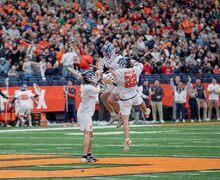SUNY-ESF launches online course on UV Curable 3-D printing
Illustration by Tony Chao I Art Director
Ultraviolet curable 3-D printing can be used to create objects as small as pieces of jewelry and as large as life size replicas of surgical patients.
Starting this semester, students at SUNY-ESF will be able to take a course on the science of that specific aspect of 3-D printing.
“Essentially what you’re taking is photopolymer chemistry — a plastic chemistry that is in a liquid form — that you’re curing with ultraviolet light, which is an instant cure as opposed to drying,” said Doreen Monteleone, a Radiation Curing Program manager at the State University of New York College of Environmental Science and Forestry. “Depending upon the printing mechanism you’re using and the light force, you get this instantaneous cure.”
Monteleone helped create the new short online course at the college on the “Basics of UV Curable 3-D Printing,” which will be taught this semester. SUNY-ESF is offering several courses that focus on radiation curing technology and delve into detail about the polymer chemistry and the principles of radiation technology; this class is specific in the 3-D printing area.
“There are many companies using UV technology or 3-D technology that may want to educate their employees, or people interested in the subject can take this course online and learn more,” Monteleone said. “By having it online, it opens up the doors infinitely because anyone can reach an online course at this point.”
The inspiration behind the course was Mike Idacavage, who left Syracuse University in 1983 to work at starting a UV curing lab. Since then, he has been working in the industry of radiation curing and watching it grow and expand rapidly. In the past three to four years, Idacavage has gotten more involved with the three-dimensional printing side of UV curing, which is a small but very important subset of 3-D printing in terms of what it can be used to make.
Through interactions at 3-D printing companies, Idacavage said he realized that many end-users had no idea about the science behind the technology and set forth to design a class for non-science majors that would explain the basics and chemistry of UV curing 3-D printing.
Short courses are not taken for credit, which is beneficial to someone who simply wants to learn more about the growing technology. It is designed in such a way that should someone sit down with it continuously, they could complete the course in four to six hours.
The course is set in six modules. The first analyzes what the technology does, what the advantages are and what the disadvantages are. Modules two through five help students to better understand the chemistry behind the technology — how it works, what chemicals are used and why they make a 3-D printed object. The last module focuses on safety and handling. Students are given a month to work through all the lectures, modules and quizzes at the end of each module.
Though the technology has been around for the past 10–15 years, Idacavage said how it works is a mystery to most people.
The uses for this technology range vastly — it can be used on a small scale to make fashion dresses or jewelry, or on a large scale where companies can custom-design and make something for an individual consumer that is perfectly fitted for them, Monteleone said. One of the most common uses is in dentistry — it’s used to fill teeth. It’s essentially putting a substance in your tooth, filling it and curing it with ultraviolet light.
“One of the most interesting applications was the CT scan of a mummy in Ohio and they made a perfect replica of the person inside it and (studied) it,” Idacavage said.
The technology can also be used by doctors going into surgery to print out and practice on a perfect life-size replica of the body they are going to operate on.
“You kind of have to think outside of the box in what it can be used for,” Monteleone said.
Said Idacavage: “Once you learn about it, it’s hard to make decisions on what you can do and how to push it to the limit.”
Published on January 12, 2015 at 12:01 am
Contact Anjali: acalwis@syr.edu





